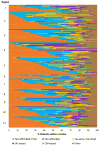National Variation in Use of Immunosuppression for Kidney Transplantation: A Call for Evidence-Based Regimen Selection
- PMID: 26901466
- PMCID: PMC5513703
- DOI: 10.1111/ajt.13758
National Variation in Use of Immunosuppression for Kidney Transplantation: A Call for Evidence-Based Regimen Selection
Abstract
Immunosuppression management in kidney transplantation has evolved to include an increasingly diverse choice of medications. Although informed by patient and donor characteristics, choice of immunosuppression regimen varies widely across transplant programs. Using a novel database integrating national transplant registry and pharmacy fill records, immunosuppression use at 6-12 and 12-24 mo after transplant was evaluated for 22 453 patients transplanted in 249 U.S. programs in 2005-2010. Use of triple immunosuppression comprising tacrolimus, mycophenolic acid or azathioprine, and steroids varied widely (0-100% of patients per program), as did use of steroid-sparing regimens (0-77%), sirolimus-based regimens (0-100%) and cyclosporine-based regimens (0-78%). Use of triple therapy was more common in highly sensitized patients, women and recipients with dialysis duration >5 years. Sirolimus use appeared to diminish over the study period. Patient and donor characteristics explained only a limited amount of the observed variation in regimen use, whereas center choice explained 30-46% of the use of non-triple-therapy immunosuppression. The majority of patients who received triple-therapy (79%), cyclosporine-based (87.6%) and sirolimus-based (84.3%) regimens continued them in the second year after transplant. This population-based study of immunosuppression practice demonstrates substantial variation in center practice beyond that explained by differences in patient and donor characteristics.
Keywords: clinical research/practice; health services and outcomes research; immunosuppressant; immunosuppressive regimens; kidney transplantation/nephrology; maintenance; steroid.
© Copyright 2016 The American Society of Transplantation and the American Society of Transplant Surgeons.
Conflict of interest statement
The authors of this manuscript have no conflicts of interest to disclose as described by the American Journal of Transplantation.
Figures


Similar articles
-
Tacrolimus plus mycophenolate mofetil vs. cyclosporine plus everolimus in deceased donor kidney transplant recipients: three-yr results of a single-center prospective clinical trial.Clin Transplant. 2013 Jul-Aug;27(4):E359-67. doi: 10.1111/ctr.12141. Epub 2013 May 26. Clin Transplant. 2013. PMID: 23710603 Clinical Trial.
-
Reduction of Extended-Release Tacrolimus Dose in Low-Immunological-Risk Kidney Transplant Recipients Increases Risk of Rejection and Appearance of Donor-Specific Antibodies: A Randomized Study.Am J Transplant. 2017 May;17(5):1370-1379. doi: 10.1111/ajt.14109. Epub 2017 Jan 3. Am J Transplant. 2017. PMID: 27862923 Clinical Trial.
-
Comparison of four different immunosuppression protocols without long-term steroid therapy in kidney recipients monitored by surveillance biopsy: five-year outcomes.Transpl Immunol. 2008 Nov;20(1-2):32-42. doi: 10.1016/j.trim.2008.08.005. Epub 2008 Sep 4. Transpl Immunol. 2008. PMID: 18773960 Clinical Trial.
-
Calcineurin inhibitor-free immunosuppression in pediatric renal transplantation: a viable option?Paediatr Drugs. 2011 Feb 1;13(1):49-69. doi: 10.2165/11538530-000000000-00000. Paediatr Drugs. 2011. PMID: 21162600 Review.
-
Optimizing the clinical utility of sirolimus-based immunosuppression for kidney transplantation.Clin Transplant. 2019 Feb;33(2):e13464. doi: 10.1111/ctr.13464. Epub 2019 Jan 2. Clin Transplant. 2019. PMID: 30548896 Review.
Cited by
-
The impact of direct-acting antiviral agents on liver and kidney transplant costs and outcomes.Am J Transplant. 2018 Oct;18(10):2473-2482. doi: 10.1111/ajt.14895. Epub 2018 May 29. Am J Transplant. 2018. PMID: 29701909 Free PMC article.
-
Center practice drives variation in choice of US kidney transplant induction therapy: a retrospective analysis of contemporary practice.Transpl Int. 2018 Feb;31(2):198-211. doi: 10.1111/tri.13079. Epub 2017 Nov 2. Transpl Int. 2018. PMID: 28987015 Free PMC article.
-
Eplet Mismatch Load and De Novo Occurrence of Donor-Specific Anti-HLA Antibodies, Rejection, and Graft Failure after Kidney Transplantation: An Observational Cohort Study.J Am Soc Nephrol. 2020 Sep;31(9):2193-2204. doi: 10.1681/ASN.2020010019. Epub 2020 Aug 6. J Am Soc Nephrol. 2020. PMID: 32764139 Free PMC article.
-
Center-driven and Clinically Driven Variation in US Liver Transplant Maintenance Immunosuppression Therapy: A National Practice Patterns Analysis.Transplant Direct. 2018 Jun 13;4(7):e364. doi: 10.1097/TXD.0000000000000800. eCollection 2018 Jul. Transplant Direct. 2018. PMID: 30046654 Free PMC article.
-
Adequate tacrolimus exposure modulates the impact of HLA class II molecular mismatch: a validation study in an American cohort.Am J Transplant. 2021 Jan;21(1):322-328. doi: 10.1111/ajt.16290. Epub 2020 Oct 11. Am J Transplant. 2021. PMID: 32888256 Free PMC article.
References
-
- Lentine KL, Gheorghian A, Axelrod D, Kalsekar A, L’Italien G, Schnitzler MA. The implications of acute rejection for allograft survival in contemporary U.S. kidney transplantation. Transplantation. 2012;94(4):369–76. - PubMed
-
- Alangaden GJ, Thyagarajan R, Gruber SA, Morawski K, Garnick J, El-Amm JM, et al. Infectious complications after kidney transplantation: current epidemiology and associated risk factors. Clin Transplant. 2006;20(4):401–9. - PubMed
-
- Pourmand G, Salem S, Mehrsai A, Taherimahmoudi M, Ebrahimi R, Pourmand M. Infectious complications after kidney transplantation: a single-center experience. Transplant Infectious Disease. 2007;9(4):302–9. - PubMed
-
- Lentine KL, Brennan DC, Schnitzler MA. Incidence and predictors of myocardial infarction after kidney transplantation. Journal of the American Society of Nephrology. 2005;16(2):496–506. - PubMed
MeSH terms
Substances
Grants and funding
LinkOut - more resources
Full Text Sources
Other Literature Sources
Medical
Miscellaneous

